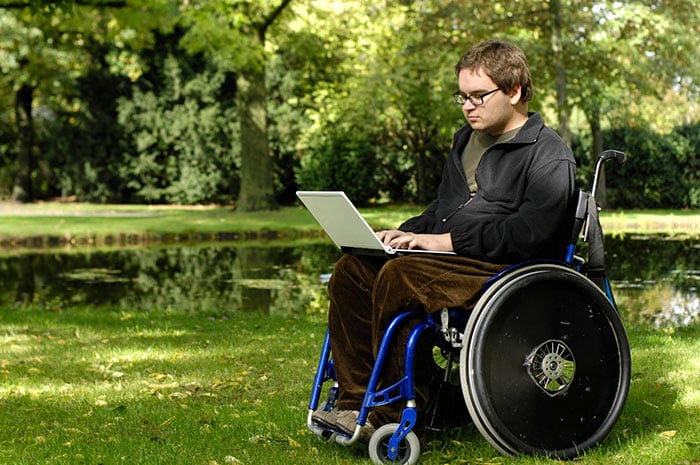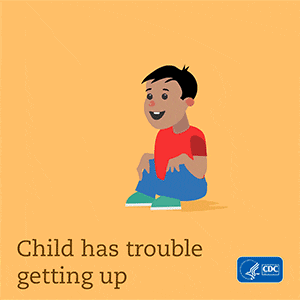What is Muscular Dystrophy?

Muscular dystrophies are a group of muscle diseases caused by mutations in a person’s genes. Over time, muscle weakness decreases mobility, making everyday tasks difficult. There are many kinds of muscular dystrophy, each affecting specific muscle groups, with signs and symptoms appearing at different ages, and varying in severity. Muscular dystrophy can run in families, or a person can be the first in their family to have a muscular dystrophy. There may be several different genetic types within each kind of muscular dystrophy, and people with the same kind of muscular dystrophy may experience different symptoms.
Muscular dystrophies are rare, with little data on how many people are affected. The Centers for Disease Control and Prevention (CDC) is working to estimate the number of people with each major kind of muscular dystrophy in the United States.
Learn more about CDC’s research on muscular dystrophy »
Kinds of Muscular Dystrophy
The information on this page is a brief overview of the major kinds of muscular dystrophy.
Duchenne muscular dystrophy (DMD) and Becker muscular dystrophy (BMD) can have the same symptoms and are caused by mutations in the same gene. BMD symptoms can begin later in life and be less severe than DMD. However, because these two kinds are very similar, they are often studied and referred to together (DBMD).
How many people are affected?
About 14 in 100,000 males 5 – 24 years of age
Who is more likely to be affected: males or females?
Males
When does muscle weakness typically begin?
DMD symptoms usually begin before 5 years of age. In BMD, symptoms usually appear later, even into adulthood.
Which parts of the body show weakness first?
Upper legs and upper arms
What other parts of the body can be affected?
Heart, lungs, throat, stomach, intestines, and spine
How many people are affected?
About 8 in 100,000 people of all ages are affected
Who is more likely to be affected: males or females?
Males and females equally
When does muscle weakness typically begin?
Usually between 10–30 years of age, but ranges from birth to 70 years old.
Which parts of the body show weakness first?
Face, neck, arms, hands, hips, and lower legs
What other parts of the body can be affected?
Heart, lungs, stomach, intestines, brain, eyes, and hormone-producing organs
How many people are affected?
About 2 in 100,000 people of all ages
Who is more likely to be affected: males or females?
Males and females equally
When does muscle weakness typically begin?
Childhood or adulthood, depending on the type of LGMD
Which parts of the body show weakness first?
Upper arms, upper legs
What other parts of the body can be affected?
Heart, spine, hips, calves, and trunk
How many people are affected?
About 4 in 100,000 people of all ages
Who is more likely to be affected: males or females?
Males and females equally
When does muscle weakness typically begin?
Young adulthood
Which parts of the body show weakness first?
Face, shoulders, and upper arms
What other parts of the body can be affected?
Eyes, ears, and lower legs
How many people are affected?
About 1 in 100,000 people of all ages
Who is more likely to be affected: males or females?
Males and females equally
When does muscle weakness typically begin?
At birth or in early infancy
Which parts of the body show weakness first?
Neck, upper arms, upper legs, and lungs
What other parts of the body can be affected?
Brain, heart, and spine
How many people are affected?
Less than 1 in 100,000 people
Who is more likely to be affected: males or females?
Males and females equally
When does muscle weakness typically begin?
Adulthood
Which parts of the body show weakness first?
Feet, hands, lower legs and lower arms
What other parts of the body can be affected?
Heart, arms, and legs
How many people are affected?
Less than 1 in 100,000 people
Who is more likely to be affected: males or females?
Males and females equally
When does muscle weakness typically begin?
After 40 years of age
Which parts of the body show weakness first?
Eyes and throat
What other parts of the body can be affected?
Shoulders, upper legs, and hips
How many people are affected?
Less than 1 in 100,000 people of all ages
Who is more likely to be affected: males or females?
Males
When does muscle weakness typically begin?
Childhood
Which parts of the body show weakness first?
Arms, legs, heart, and joints
What other parts of the body can be affected?
Throat, shoulders, and hips
- Connect with an organization that focuses on the type of muscular dystrophy affecting you or someone in your family.
- Read about CDC’s Muscular Dystrophy Surveillance Tracking and Research Network, known as MD STARnet.
- Learn more about CDC’s other muscular dystrophy projects.
References for this page
- Zhang Y, Mann JR, James KA, et al. Duchenne and Becker Muscular Dystrophies’ Prevalence in MD STARnet Surveillance Sites: An Examination of Racial and Ethnic Differences. Neuroepidemiology. 2021 Mar;55(1):47-55.
- Romitti PA, Zhu Y, Puzhankara S, et al. Prevalence of Duchenne and Becker muscular dystrophies in the United States. Pediatrics. 2015 Mar;135(3):513-21.
- Ciafaloni E, Fox DJ, Pandya S, et al. Delayed diagnosis in Duchenne muscular dystrophy: Data from the Muscular Dystrophy Surveillance, Tracking, and Research Network (MD STARnet). J Pediatr. 2009 Sept;155(3):380-5
- Thomas S, Conway KM, Fapo O et al. Time to diagnosis of Duchenne muscular dystrophy remains unchanged: Findings from the Muscular Dystrophy Surveillance, Tracking, and Research Network, 2000-2015. Muscle Nerve. 2022 Mar;66(2):193-197.
- Sahay KM, Smith T, Conway KM, et al. A review of MD STARnet’s research contributions to pediatric-onset dystrophinopathy in the United States; 2002–2017. J Child Neurol. 2019 Jan;34(1):44-53.
- Mah JK, Korngut L, Fiest KM, et al. A systematic review and meta-analysis on the epidemiology of the muscular dystrophies. Can J Neurol Sci. 2016 Jan;43:163-77.
- Hilbert JE, Ashizawa T, Day JW, et al. Diagnostic odyssey of patients with myotonic dystrophy. J Neurol. 2013 Oct;260:2497-2504.
- Turner C, Hilton-Jones D. Myotonic dystrophy: Diagnosis, management and new therapies. Curr Opin Neurol. 2014 Oct;27:599-606.
- Narayanaswami P, Weiss M, Selcen D, et al. Evidence-based guideline summary: Diagnosis and treatment of limb-girdle and distal dystrophies: Report of the guideline development subcommittee of the American Academy of Neurology and the practice issues review panel of the American Association of Neuromuscular & Electrodiagnostic Medicine. Neurology. 2014 Oct;83:1453-63.
- Khadilkar SV, Patel BA, Lalkaka JA. Making sense of the clinical spectrum of limb girdle muscular dystrophies. Practical Neurology. 2018 Jun;18:201-210.
- Wang LH, Tawil R. Facioscapulohumeral dystrophy. Curr Neurol Neurosci Rep. 2016 Jul;16:66.
- Wang CH, Bonnemann CG, Rutkowski A, et al. Consensus statement on standard of care for congenital muscular dystrophies. J Child Neurol. 2010 Dec;25:1559-81.
- Norwood FL, Harling C, Chinnery PF, Eagle M, Bushby K, Straub V. Prevalence of genetic muscle disease in Northern England: In-depth analysis of a muscle clinic population. Brain. 2009 Nov;132(Pt 11):3175-86.
- Dimachkie MM, Barohn RJ. Distal myopathies. Neurol Clin. 2014 Aug;32:817-42.
- Richard P, Trollet C, Stojkovic T, et al. Correlation between PABPN1 genotype and disease severity in oculopharyngeal muscular dystrophy. Neurology. 2017 Jan;88:359-365.
- Bonne G, Leturcq F, Ben Yaou R. Emery-Dreifuss muscular dystrophy. 2004 Sep 29 [updated 2015 Nov 25]. In: Pagon RA, Adam MP, Ardinger HH, Wallace SE, Amemiya A, Bean LJH, Bird TD, Ledbetter N, Mefford HC, Smith RJH, Stephens K, editors. GeneReviews® [Internet]. Seattle (WA): University of Washington, Seattle; 1993-2017.
